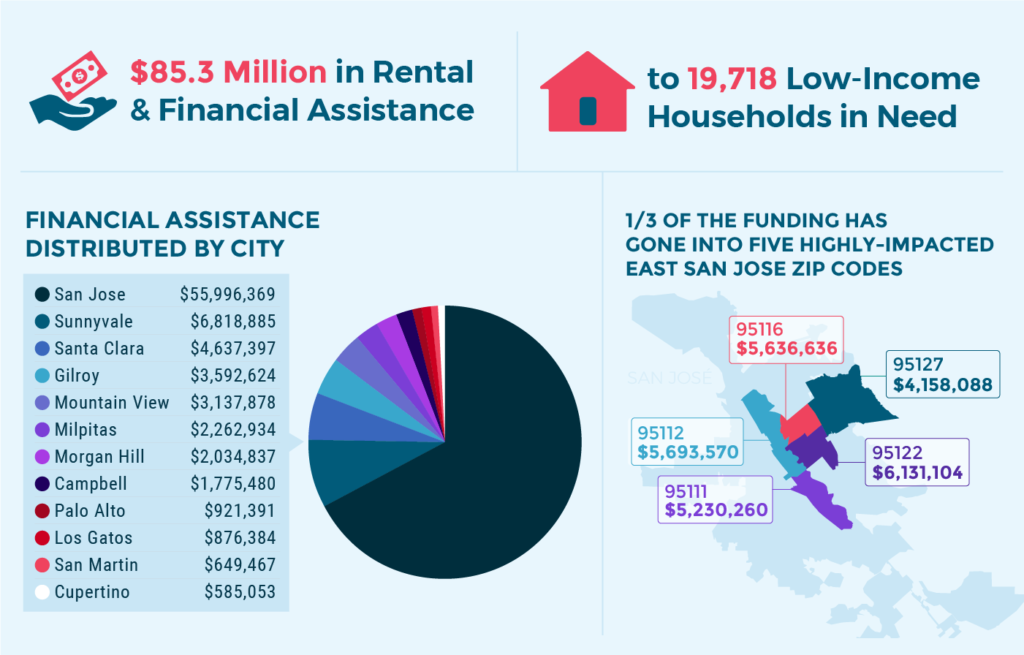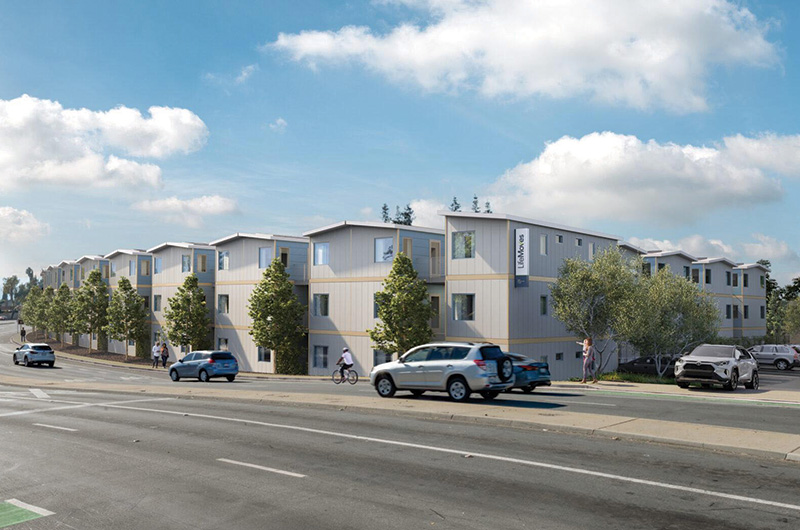Responding to the COVID-19 Pandemic
The coalition was put to the test in early 2020 when COVID-19 started spreading throughout Santa Clara County. The pandemic placed individuals who were homeless or at risk of homelessness in an even more precarious situation. In addition to the public health concerns related to people living in crowded shelters or on the streets, the economic impacts of COVID-19 on those living paycheck to paycheck threatened to push even more people into homelessness.
Financial Assistance for At-Risk Households
In March 2020, the coalition quickly mobilized a countywide response to prevent the thousands of low-income households whose family members lost jobs or were put on furlough from being pushed out of their homes. Led by Destination: Home, the region pioneered the nation’s first COVID rental assistance fund, raising an initial $12 million in critical financial aid in the first few weeks of the pandemic. Within three days, however, they received thousands of calls for assistance and the initial funding was exhausted.
Additional financial aid was necessary, and Destination: Home worked with a group of elected leaders and private sector partners to raise additional funding to bridge the gap. Over the next year-and-a-half, they secured tens-of-millions of dollars in funding from roughly four dozen public, private and philanthropic donors, including an additional $10 million in funding from Cisco.
Since the Homelessness Prevention System only had the capacity to serve about 1,500 individuals per year, Destination: Home and Sacred Heart Community Service brought together a coalition of more than 70 organizations already working in underserved neighborhoods to help distribute funding more quickly and reach communities where it was most needed.
The City of San Jose and County of Santa Clara Counties also adopted the nation’s first eviction moratorium to help keep people in their homes, and would later allocate tens of millions of dollars in additional federal relief funds into this effort.
This comprehensive, collaborative endeavor delivered more than $85 million in rental and financial assistance to 19,695 low-income households during the pandemic—of which 82% were extremely low income, 64% were families with children, and 94% were people of color. One-third of the funding went into five of the most highly-impacted East San Jose zip codes.

Assisting Homeless Residents During the Pandemic
“We ended up with a pretty low transmission rate among our homeless population, which was unlike other places—because it was such a coordinated, fast effort. ”
Jen Loving, CEO, Destination: Home
At the same time as they were coordinating a robust financial assistance program, the coalition was also mobilizing to meet the needs of unsheltered individuals during the pandemic.
The County of Santa Clara and the City of San Jose established emergency field offices and committed to closely coordinate their homelessness responses. The County of Santa Clara took the lead on leasing 13 hotels/motels across 8 cities, while the City of San Jose led the charge to stand up new temporary non-congregate facilities. They also jointly convened all non-profit shelter providers throughout the county, meeting twice per week to coordinate and troubleshoot problems, and collaborated on a centralized shelter hotline and referral system that is still helping to coordinate temporary shelter placements post-pandemic. Overall, the system aided nearly 5,000 homeless individuals in finding appropriate shelter during the crisis.

To deal with immediate health and safety concerns, Destination: Home worked with other members of the coalition to create a supply program for service agencies, which successfully distributed more than 100,000 pieces of personal protective equipment (PPE) to shelters, outreach teams, and various other partners. Partners within the coalition also established mobile shower and sanitation services; provided tents, tarps, and other supplies for those living in encampments; and developed a small grant program to address emerging needs among nonprofit service providers.
A Testament to the Collective Impact Model
The COVID-19 crisis showcased the profound stability and effectiveness of the collaborative system that the coalition had established over the previous decade. The existing collective impactA concept first introduced in the Stanford Social Innovation Review in 2011, collective impact is a framework for deep and sustained collaboration between actors from different sectors to solve a specific social problem. Successful collective impact initiatives include a common agenda, shared measurement systems, mutually reinforcing activities, continuous communication, and backbone support organizations. model—built on trust and collaboration—ensured a faster and more effective response in a time of immense crisis. In fact, in a testament to the level of trust and collaboration built between members of this coalition, the City of San Jose Housing Department and County of Santa Clara Office of Supportive HousingA type of housing unit or program that combines affordable housing with support services (for example, mental health, employment, or peer support services) that has proven successful in helping homeless individuals become and stay housed. Supportive housing programs can come in many forms, including long-term programs (i.e., Permanent Supportive Housing) and shorter-term support (i.e., Rapid Rehousing). even launched a joint, interagency operational center to coordinate their respective homelessness initiatives during the pandemic.
And even as the coalition pivoted to respond to the urgent needs brought on by the pandemic, the system continued to advance the overall goal of connecting more homeless people to permanent housing – with more than 3,200 individuals housed in 2020 during the height of the pandemic.
